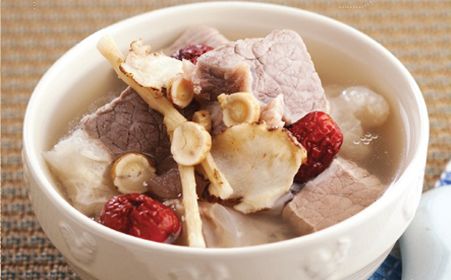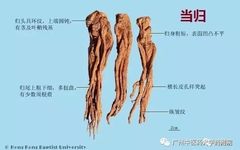
“Xiao Han, Da Han freeze into a lump,” during the period from “Xiao Han” to “Da Han,” the temperature in most parts of our country is at its lowest for the year. After the consumption of the body’s organs and yin-yang qi and blood throughout spring, summer, and autumn, there will be some deficiency. Reasonable supplementation during this period can timely replenish qi, blood, and body fluids, resist the invasion of severe cold, and reduce the incidence of diseases in the coming year, thus achieving the goal of health preservation with half the effort.
Modern women often complain about cold hands and feet, pale or sallow complexion, pale lips and nails, dizziness, tinnitus, insomnia, forgetfulness, or scanty menstrual flow with light color, which are mostly symptoms of blood deficiency. So how can we replenish blood? Today, we will discuss the holy herb for blood replenishment—Dang Gui (Angelica Sinensis).
Dang Gui
It is the dried root of the plant Angelica Sinensis from the Umbelliferae family. It is harvested in late autumn, with the fibrous roots and soil removed, and after some moisture evaporates, it is bundled into small bunches and dried slowly with smoke and fire. Dang Gui is sweet and pungent, with a warm nature. It enters the liver, heart, and spleen meridians. It has the effects of replenishing blood, activating blood circulation, regulating menstruation, relieving pain, and moistening the intestines to relieve constipation. When used medicinally, it can be divided into whole Dang Gui, Gui Shen (the body), Gui Tou (the head), and Gui Wei (the tail). Gui Tou and Gui Wei are more focused on activating blood and breaking blood stasis; Gui Shen is more focused on replenishing and nourishing blood; while whole Dang Gui can both replenish and activate blood. The processed product, wine Dang Gui, has the effect of activating blood and regulating menstruation.

▲Whole Dang Gui
The Origin of the Name Dang Gui
There is a riddle in the folk saying: “At the end of May and the beginning of June, a beautiful woman buys paper to paste the windows, and her husband has been away for three years, sending no letters.” Guess the four medicinal herbs. Some friends may know the answer; indeed, they are “Ban Xia (Pinellia), Fang Feng (Siler), Dang Gui (Angelica Sinensis), and Bai Zhi (Angelica Dahurica).” Among them, the phrase “the husband has been away for three years” refers to Dang Gui, meaning that the husband should return quickly after being away for three years, reflecting the wife’s deep longing for her husband who is still far away. The Compendium of Materia Medica records: “Dang Gui regulates blood and is an essential medicine for women, with the meaning of longing for a husband, hence the name Dang Gui.” A Tang poem states: “Hua Ma (Sesame) is easy to plant but no one plants it, just when it is time to return but does not return,” which aptly reflects the name Dang Gui. Look, the names of Chinese herbs can be so full of sentiment.
How to Easily Identify Dang Gui
1. First, look at it; genuine Dang Gui slices present a yellowish-white or light yellow-brown color.
2. Next, smell it; a strong aroma is preferred.
3. Finally, taste it; Dang Gui has a sweet taste, with a slight bitterness, but it should not numb the tongue.
Dang Gui is soft and flexible, with a cross-section that is yellowish-white or light yellow-brown, thick skin, with cracks and many brown dot-like secretion cavities, and the wood part is lighter in color, forming a yellow-brown ring. It has a strong aroma, with a sweet, pungent, and slightly bitter taste.

▲Dang Gui (slices)
Commonly seen on the market is the use of Du Huo (Angelica Pubescens) as a substitute; Du Huo is also an Umbelliferae plant, but it is harder in texture, and when damp, it becomes soft. The cross-section of its skin is grayish-white, with many scattered brown oil chambers, and the wood part is grayish-yellow to yellow-brown, forming a brown ring. It has a distinctive aroma, with a bitter, pungent, and slightly numbing taste.

▲Du Huo (slices)
Although Dang Gui and Du Huo look similar, their effects are quite different. Dang Gui can replenish blood, activate blood circulation, and moisten the intestines to relieve constipation, while Du Huo can dispel wind, overcome dampness, disperse cold, and relieve pain. When purchasing Dang Gui, everyone should pay attention to careful identification. If you have not yet reached the ability to distinguish the “fish from the dragons” in the herbal market, it is recommended to buy medicine from regular pharmacies or hospitals.
Recommended Dietary Therapy with Dang Gui:

1. Take 10 grams of Dang Gui and a few red dates, add an appropriate amount of water in a clay pot, boil, and after boiling, add several eggs and cook until the eggs are done. Eat the eggs and red dates, and drink the soup, which has a good effect on replenishing blood and regulating menstruation.
2. Take 15 grams each of Dang Gui and Dang Shen (Codonopsis Pilosula), and one hen, simmer on low heat until tender, add an appropriate amount of salt, eat the meat and drink the soup, suitable for liver and spleen blood deficiency.
3. Take 20 grams of Dang Gui, 30 grams of ginger, 500 grams of lamb, and an appropriate amount of yellow wine and salt to stew; Dang Gui lamb soup is also a famous dietary therapy for improving yang deficiency constitution.
Warm Reminder: Although Dang Gui is nourishing, it is not suitable for everyone. Due to its sweet and warm nature, it is not recommended for those with spleen dampness, heat excess bleeding, or yin deficiency with yang excess; also, because it moistens dryness and lubricates the intestines, it should be used cautiously in cases of loose stools. Women during menstruation and pregnancy should use it under the guidance of a physician.

Source|First Affiliated Hospital of Guangzhou University of Chinese Medicine
Executive Editor|Jiang Qiyu
Editor-in-Chief|Zhang Qiuzhen
Review|Lan Shaoqing
